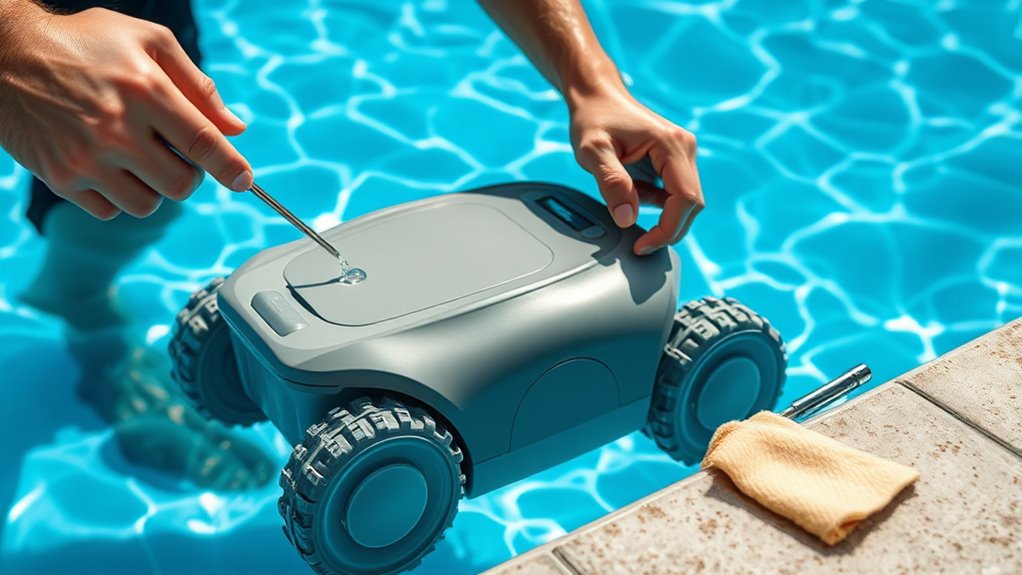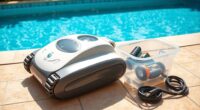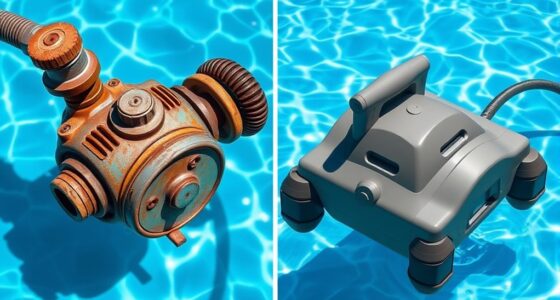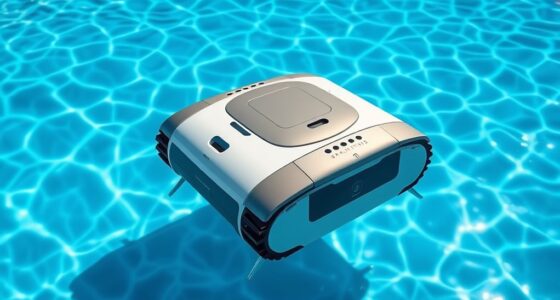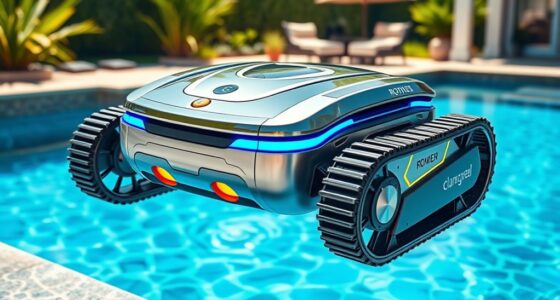To keep your robotic pool cleaner running smoothly, regularly empty and inspect the filter, ensuring it’s free of debris. Clean brushes and scrapers to prevent buildup, and check intake vents for blockages. Inspect the power cord and connectors for damage and test the battery and charger. Store your robot properly when not in use, update firmware regularly, and watch for unusual noises. Continue exploring for detailed tips to optimize your cleaner’s performance.
Key Takeaways
- Regularly check and clean filters and intake vents to prevent clogs and ensure optimal debris removal.
- Inspect and maintain brushes, wheels, and mechanical parts for damage, debris buildup, and smooth operation.
- Examine electrical components, sensors, and power cords for dirt, damage, and proper connections.
- Store the cleaner properly, update firmware, and schedule professional inspections for long-term performance.
- Monitor for signs of malfunction, perform routine cleaning, and replace worn parts to extend the device’s lifespan.
Regularly Empty and Inspect the Filter

To keep your robotic pool cleaner functioning efficiently, it is vital to regularly empty and inspect its filter. Proper filter maintenance guarantees debris removal is effective, preventing clogs that can hinder performance. Start by removing the filter from the cleaner and checking for any accumulated dirt, leaves, or other debris. If the filter appears dirty, rinse it thoroughly with a hose to remove debris and restore proper flow. Regular inspections help you spot wear and tear early, extending the filter’s lifespan. Make it a routine to clean the filter after each use or at least weekly during heavy debris seasons. Additionally, understanding the filter type and its specific maintenance needs can further improve your cleaning efficiency. Using the correct cleaning techniques ensures optimal filter performance and prolongs its life. Being aware of allergy risks and allergies related to certain seeds can help you avoid potential health issues during maintenance routines involving seed-based products. Also, consulting the manufacturer’s instructions can provide valuable guidance on filter replacement schedules to keep your cleaner in top condition. Incorporating regular maintenance routines ensures your robotic cleaner continues to operate smoothly and efficiently. By maintaining a clean filter, you ensure your robotic cleaner works at its best, keeping your pool spotless with minimal effort.
Clean the Robotic Cleaner’s Brushes and Scrapers

Regularly cleaning the brushes and scrapers on your robotic pool cleaner is essential for maintaining ideal performance. Proper brush maintenance and scraper inspection prevent debris buildup and ensure smooth operation. To keep your cleaner in top shape:
Regular cleaning of brushes and scrapers keeps your robotic pool cleaner running smoothly.
- Remove the brushes and scrub them with a brush or sponge to remove dirt and algae.
- Inspect the scrapers for cracks or damage, replacing if necessary.
- Check the brush bearings and pivot points, lubricating or adjusting as needed.
- Ensuring the color accuracy of the cleaner’s components can improve visual diagnostics during maintenance. Additionally, keeping the component integrity intact helps prevent unexpected breakdowns and maintains overall efficiency. Regular inspection of the exfoliation process in your cleaner’s parts can help identify early signs of wear before major issues develop. This routine helps maintain peak cleaning efficiency and prolongs the lifespan of your robotic cleaner. Focus on removing any tangled debris and ensuring the brushes spin freely. Maintaining regional knowledge of your pool environment and the cleaner’s components can also aid in effective troubleshooting and timely repairs. Incorporating preventive maintenance strategies can further extend the life of your cleaner and improve its performance. Keeping the scrapers in good condition prevents ineffective scraping and ensures your pool stays sparkling clean. Regular maintenance now saves time and money later.
Check and Clear the Intake Vents
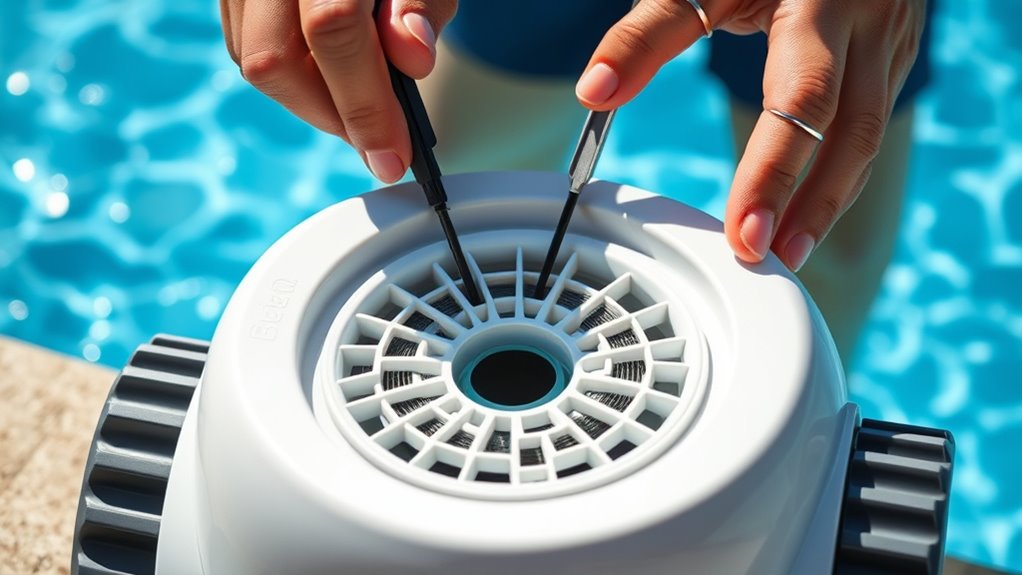
Start by inspecting the vent openings to spot any debris or blockages. If you find obstructions, remove them carefully using the right cleaning tools to avoid damaging the vents. Regular checks guarantee your cleaner operates efficiently and keeps your pool pristine. Additionally, ensuring that the intake system is properly maintained can prevent performance issues and extend the lifespan of your robotic pool cleaner. Monitoring the horsepower of electric motors in your cleaner can help optimize its power and efficiency. Incorporating routine maintenance practices can help identify potential problems early and maintain optimal functioning. Regularly evaluating the airflow within the system can further enhance performance and prevent overheating. Staying informed about security features and updates can further enhance your equipment’s reliability.
Inspect Vent Openings
Have you checked the intake vents lately? Regularly inspecting your robotic pool cleaner’s vent openings guarantees proper airflow maintenance. Blocked vents can reduce efficiency and strain the motor. Here are three key steps:
- Visually inspect the vent openings for dirt, debris, or buildup.
- Gently clean the vents with a soft brush or cloth to remove obstructions.
- Ensure no debris is lodged inside, as it could restrict airflow.
- Regular maintenance of airflow management ensures your cleaner operates at peak performance. Proper airflow is essential for motor health, preventing overheating and prolonging the lifespan of your device.
Keeping vent openings clear allows your cleaner to operate smoothly and prevents overheating. Remember, neglecting this step can lead to decreased performance and potential damage. Regular inspection and cleaning are simple yet essential parts of routine maintenance for your robotic pool cleaner. Proper airflow maintenance keeps it running efficiently to clean your pool effectively.
Remove Obstructions Carefully
To guarantee your robotic pool cleaner functions properly, it’s important to carefully check and clear the intake vents of any obstructions. During obstruction removal, examine the vents for debris, leaves, or other blockages that could hinder performance. Use your fingers or a soft brush to gently dislodge any debris stuck in the vents, avoiding damage to the components. Proper debris clearance ensures the cleaner maintains peak suction and movement. Additionally, regular inspection of sound healing science can help identify subtle vibrations or noises indicating hidden obstructions or mechanical issues. Be thorough but gentle, and make sure no obstructions remain that could cause the robot to get stuck or work inefficiently. Regular inspection and cleaning of nutcracker selection can help prevent damage to the intake vents from hard or stuck debris. Keeping these vents clear is essential for smooth, effective operation. Monitoring AI vulnerabilities is also important to ensure your device remains functioning securely and effectively. Additionally, understanding dog breed characteristics can help in choosing and maintaining your cleaning equipment effectively for specific needs. Regular maintenance and attention to performance optimization can further enhance your pool cleaner’s longevity and efficiency.
Use Appropriate Cleaning Tools
Using the right cleaning tools makes checking and clearing the intake vents more effective and safe. Start by selecting a soft cleaning brush suitable for delicate surfaces to avoid damaging the cleaning brushstrokes or sensors. Next, follow these steps:
- Gently inspect sensors around the intake vents to spot any dirt or debris.
- Use a small brush or compressed air to carefully remove obstructions from vents and sensors.
- Wipe down the area with a damp cloth to remove residual grime and ensure smooth airflow.
- Regularly inspecting sensors and cleaning with appropriate tools helps prevent malfunctions and sensor damage.
- Incorporating routine maintenance into your cleaning schedule ensures your robotic pool cleaner remains in optimal condition. Additionally, understanding the environmental considerations of your pool area can help prevent buildup and maintain cleaner operation.
- Being aware of sensor calibration techniques can further enhance the cleaning performance and longevity of your device.
Proper tools prevent damage and ensure thorough cleaning. Regularly inspecting sensors and cleaning with appropriate tools keeps your robotic pool cleaner functioning *at its best*, reducing downtime and extending its lifespan.
Examine the Power Cord and Connectors

Start by inspecting the power cord and connectors for any signs of damage or wear. Make sure all connections are clean, free of debris, and securely attached. Address any issues immediately to keep your robotic pool cleaner functioning safely and efficiently. Additionally, understanding the family dynamics behind your equipment can help in troubleshooting and maintenance routines.
Inspect for Damage
Regularly inspecting the power cord and connectors for damage is essential to keep your robotic pool cleaner running smoothly. Start by examining the entire length of the cord for cuts, frays, or exposed wires. Next, check the connectors for corrosion, cracks, or loose fittings that could affect power flow. Pay close attention to the robotic arm and control panel connections, ensuring they’re secure and undamaged. Here are three key steps:
- Look for any visible damage or wear on the power cord.
- Inspect connectors for corrosion, cracks, or looseness.
- Ensure the connection points to the robotic arm and control panel are secure.
Address any issues immediately to prevent operational failures and prolong your cleaner’s lifespan.
Clean and Secure Connections
To guarantee your robotic pool cleaner operates smoothly, it’s important to clean and secure the connections between the power cord and the device. Check the connection integrity regularly to make certain there are no signs of wear or corrosion. Carefully inspect the fittings for any looseness or damage, as loose or insecure fittings can cause operational issues or electrical hazards. Wipe down the connectors with a damp cloth to remove dirt and debris that could interfere with the connection. Make sure the fittings are tightly secured and properly aligned before plugging in. Maintaining secure fittings helps prevent disruptions during cleaning cycles and extends the lifespan of your cleaner. Regularly verifying these connections keeps your robotic pool cleaner functioning efficiently and safely.
Test the Battery and Charging Components

Before using your robotic pool cleaner, it’s essential to verify that the battery and charging components are functioning properly. This ensures ideal battery lifespan and charging safety. To do this, follow these steps:
- Check the charge indicator light to confirm proper charging. If it doesn’t light up or shows an error, inspect the charger and connections.
- Use a multimeter to test the battery voltage, ensuring it’s within the recommended range for your model.
- Observe how long it takes to fully charge; prolonged charging times may indicate a need for replacement or repair.
Regular testing prevents unexpected downtime, extends battery life, and maintains safe charging practices. Staying proactive saves you time and money in the long run.
Inspect the Wheels and Tracks for Debris

Since debris can easily clog the wheels and tracks, it’s important to inspect them thoroughly after each cleaning session. During wheel maintenance, check for dirt, leaves, or hair wrapped around the axles and remove any buildup. For track inspection, look for obstructions or debris lodged between the treads that could hinder movement. Clear away any debris to guarantee smooth operation and prevent unnecessary wear. While inspecting, also examine the wheels and tracks for signs of damage or excessive wear. Proper wheel maintenance and track inspection keep your robotic pool cleaner functioning efficiently. Regularly cleaning these components will extend their lifespan and maintain ideal cleaning performance. Always make sure the wheels spin freely and the tracks move smoothly before storing or using the robot again.
Store the Robot Properly When Not in Use

When you’re finished using your robotic pool cleaner, storing it properly guarantees it stays in good condition and works efficiently next time. Proper storage is essential for seasonal maintenance and extending your robot’s lifespan. Follow these steps:
- Clean the robot thoroughly to remove debris and prevent mold or corrosion.
- Store it in a dry, cool place away from direct sunlight to avoid damage.
- Keep the power supply and cables organized to prevent tangling or wear.
Update Firmware and Software When Available

Keeping your robotic pool cleaner’s firmware and software up to date is essential for ideal performance and security. Firmware updates often include bug fixes, new features, and improvements that enhance cleaning efficiency. Regularly check the manufacturer’s website or app for available software upgrades, as these can optimize your robot’s operation and extend its lifespan. Installing updates promptly guarantees your device runs smoothly and protects it from potential security vulnerabilities. Make sure your robot is connected to Wi-Fi or follow the manufacturer’s instructions for updating via USB or other methods. Don’t ignore update notifications; applying firmware updates and software upgrades as soon as they’re available keeps your robotic pool cleaner functioning at its best and prevents future issues.
Monitor for Unusual Noises or Performance Issues
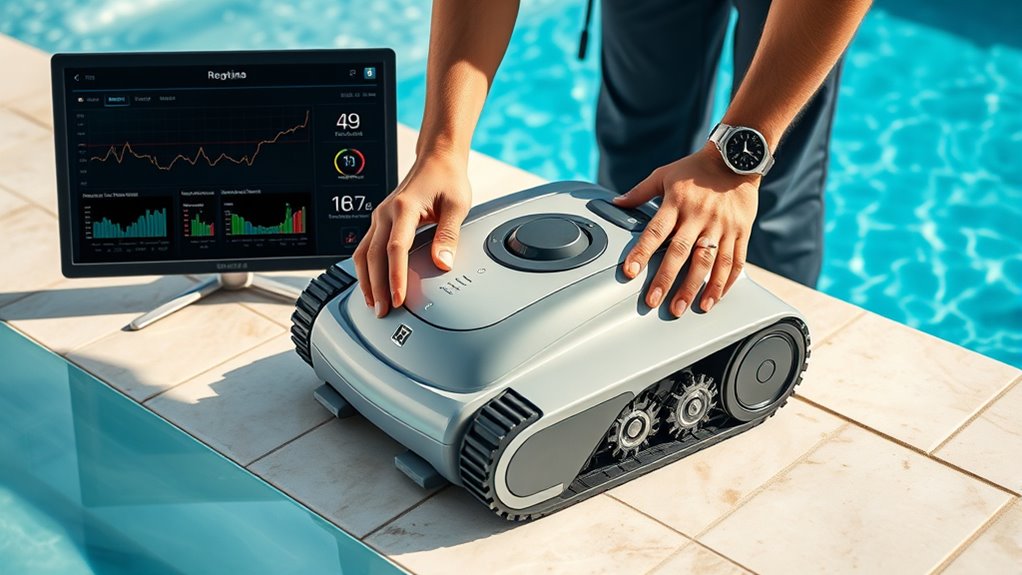
Listen carefully to your robotic pool cleaner during operation; strange noises can signal issues. If you notice unusual sounds or a sudden drop in performance, it’s time to troubleshoot. Addressing these signs early helps keep your cleaner running smoothly.
Recognize Strange Sounds
Strange sounds from your robotic pool cleaner often signal a problem that needs attention before it worsens. Paying attention to noise diagnostics helps you identify issues early. To start, focus on sound identification by noting the type of noise:
- Grinding or screeching – suggests debris or worn bearings
- Hissing or whistling – indicates air leaks or motor issues
- Loud banging or thumping – points to loose parts or obstructions
Troubleshoot Performance Drops
When your robotic pool cleaner starts missing spots or moving more slowly than usual, it’s a sign that performance issues may be cropping up. Check the water chemistry first; imbalanced pH or high mineral levels can affect the cleaner’s operation. Inspect the pool lining for debris or rough spots that might hinder movement or cause unusual noises. Make sure the brushes and wheels are clean and free of buildup, as grime can reduce efficiency. Also, verify that the filter is clean, since clogged filters strain the motor. If noise levels change or the cleaner stalls, these are signs to troubleshoot further. Regularly monitoring these factors helps maintain ideal performance and prevents small issues from escalating.
Schedule Periodic Professional Servicing

Scheduling periodic professional servicing is essential to keep your robotic pool cleaner operating at peak efficiency. Regular professional servicing ensures all components are thoroughly inspected and maintained, preventing unexpected breakdowns. During these visits, experts perform robotic pool maintenance that can spot issues early.
Regular professional servicing keeps your robotic pool cleaner running smoothly and prevents unexpected breakdowns.
Consider these benefits:
- They clean hard-to-reach areas that might be overlooked during routine checks.
- They identify and replace worn-out parts before failure occurs.
- They optimize your cleaner’s settings for maximum performance.
Frequently Asked Questions
How Often Should I Replace the Robotic Cleaner’S Filters?
You should replace your robotic cleaner’s filters when you notice decreased cleaning efficiency or after about 3 to 6 months, depending on usage. Regular filter replacement is essential for peak performance and to prevent clogging. Keep an eye on the filter’s condition and clean it frequently between replacements. Adjust your cleaning frequency based on pool debris levels, and replace filters promptly to maintain your cleaner’s effectiveness and prolong its lifespan.
What Signs Indicate My Robot Needs Professional Repairs?
Warning signs are worth monitoring for—if your robotic cleaner experiences frequent malfunctions, strange noises, or inconsistent cleaning, it’s time to take action. These robotic malfunctions could indicate a need for professional repairs, especially if your device is still under warranty coverage. Ignoring these indicators might lead to bigger issues, so promptly consult a technician to prevent costly consequences and ensure your pool stays pristine and properly protected.
Can I Use Household Cleaning Products on the Robot?
You shouldn’t use household chemicals or cleaning solutions on your robotic pool cleaner. These products can damage the delicate electronic parts and the plastic components, leading to costly repairs. Instead, use a damp cloth or a soft brush to clean your robot gently. Always follow the manufacturer’s instructions for cleaning and maintenance to guarantee your robotic pool cleaner stays in peak condition and works efficiently.
How Do I Troubleshoot Connectivity Issues With the App?
If you’re having trouble connecting your robotic pool cleaner to the app, start by checking for Wi-Fi interference from other devices or obstacles. Confirm your Wi-Fi signal is strong and stable. Next, update the app to the latest version, as outdated apps can cause connectivity issues. Restart your router and reconnect your device. These steps usually resolve most app connectivity problems, making it easier to control your pool cleaner.
Is It Safe to Leave the Robot in the Pool After Cleaning?
You might wonder if it’s safe to leave your robot in the pool after cleaning. Generally, it’s best to remove and store it properly to guarantee safe robot storage and avoid damage. Leaving it in the water can interfere with pool chemical safety and cause wear. Always follow your manufacturer’s instructions for storage, usually in a dry, cool place, to keep your robotic cleaner in good shape and maintain pool safety.
Conclusion
By following these simple maintenance tips, you can keep your robotic pool cleaner running smoothly all season. Did you know that regular upkeep can extend its lifespan by up to 50%? Staying proactive with inspections and cleanings guarantees your robot works efficiently, saving you time and money. So, set a routine, stay attentive to signs of trouble, and enjoy crystal-clear pool water with less hassle. Your pool cleaner will thank you for it!

